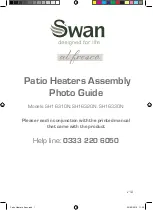
Page 8 of 16
select a flame height on the left black knob then set the thermostat black knob to a
comfort level. In both cases if the room gets too hot, the thermostat will automatically
reduce the fire to the pilot setting until the room cools. If during use the pilot is alight but
the main burner will not light, check the thermostat position and if necessary select a
warmer setting. The range of the thermostat is around 13
o
C – 55
o
C.
9.2
To light the fire, first ensure the black knob is turned clockwise to OFF. Press the left hand
(Black) control knob for several seconds then turn slowly anticlockwise to the ignition
position. A click will be heard and the pilot (under right side of fuel bed) should light. If it
does not, repeat the operation a few times to purge any air in the pipe. Continue to hold
knob for 15 – 20 second to establish the pilot and then release. If pilot fails to establish,
turn off, wait 1 minute then repeat lighting procedure. Rotate the black knob to high
flame to light then back to the desired flame position. If no gas comes through rotate the
black knob (thermostat) to a hotter room setting and the fire will light.
9.3
Control the fire by a combination of thermostat and / or flame setting to suit your mode
of use (see 9.1)
9.4
To turn the fire off, rotate the left-hand knob fully clockwise back to a vertical position.
9.5
SPARK FAILURE
The gap between the pilot electrode and the pilot should be 3.5 – 4.5mm
and normally adjustment is not necessary (the electrode is very brittle). The spark should
jump across the gap between the electrode and the gas outlet on the pilot head. If the
igniter fails, a lighted taper can be inserted into the pilot area to check that gas is reaching
the pilot.
10.
COMMISSIONING
10.1
TEST THE GAS PRESSURE
. Turn the fire on full, attach a manometer to the inlet test point
and ensure there is a pressure of 20mb (+/- 1mb) for natural gas appliances or 37mb for
propane appliances. Now turn on every other gas appliance in the house and re-check
the pressure. The pressure must still be within the tolerance of +/- 1mb. Now turn off all
the other gas appliances and turn the fire down to pilot only, the pressure must still be
within the tolerance of +/- 1mb. If it is not TRANSCO, BORD GAIS or the propane supplier
must be called to adjust the governor to the house before the fire can be commissioned
further.
Call outs to fires with incorrect pressures will be chargeable.
10.2
Brief the customer on the operation of the appliance and give them all the instructions.
The customer must be told of the need for regular servicing of the appliance, this will be
at least once a year and be made aware that no rubbish is to be thrown onto the fire bed.
The customer must also be made aware that purpose provided ventilation should be
checked regularly and not be blocked.
10.3
If you have any questions or the fire is not operating correctly, phone the Burley help-
line BEFORE you leave the installation.
If the appliance is not fitted in strict accordance with these instructions, Burley cannot
be held responsible for any damage caused and reserve the right to charge for any
corrective work. Double check standing and working pressures and securely seal all
open chimneys and flues.
10.4
Thermostat
A room temperature thermostat is provided. It is set for a normal range of
operating temperatures (13oC – 55oC) but for more accurate monitoring of room
temperature it is advised that the sensing bulb is removed from the fire and carefully
moved to a cooler location up to 1 metre away, taking care not to break or pinch the
capillary tube. We recommend that the sensing bulb is moved from the right hand side of
the fire to the left and clipped to the gas inlet pipe..
10.5
Oxygen Depletion Pilot System
There is a highly sensitive oxygen depletion sensor
designed into the pilot light and may not light first time or may extinguish after a few


































